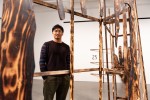Student artists featured a camera-shaped candle and body parts made of plywood for an exhibition in the New Wight Gallery.
The UCLA department of art presented the first of four MFA art showcases March 7, exhibiting the works of graduate students Jantsankhorol Erdenebayar, Maccabee Shelley and Shevaun Wright. Graduate student artist Emily Nelms Perez was also meant to display her art, but due to fire safety concerns, her work will be shown off-site at a later date. The exhibition was open to the public until Friday. While the three featured artists experimented with different media, each brought their life experiences and nonart-related interests to their installations, seen in both the works’ concepts and materials.
Wright said her law degree and six years of attorney experience directly informed her installation – the project chronicled her research into the 2006 renaming of UCLA’s Dickson Art Center into the Eli and Edythe Broad Art Center. Wright said her artwork aims to expose issues or voices that are lost within legal structures, and her research revealed a controversy over naming the center after philanthropist and entrepreneur Eli Broad.
Wright said Broad’s alleged embezzlement while on the Hammer Museum’s board of directors in 1998 should have disqualified him from having his name commemorated, as it compromises public trust in the university. Her materials visualize the process of her investigation and include scans of the documents she obtained under the California Public Records Act, as well as plaques displaying her drafted class-action suit against the Eli and Edythe Broad Foundation. Her exhibit also featured a physical copy of Broad’s memoir, “The Art of Being Unreasonable: Lessons in Unconventional Thinking” and a hanging replica of a Leonardo da Vinci manuscript the controversy centered around.
[RELATED: MFA student exhibition merges STEM, art to explore consciousness through senses]
Wright said she chose to reflect the legal themes of the exhibit through her materials, as she said the aluminum plaques of her class-action suit were meant to directly reflect a nearby plaque on the art building commemorating Broad. In addition, presenting the documents in an art exhibit not only raised awareness of the issue, but made abstract legal language more accessible, Wright said.
“(When experiencing my exhibition), I would like for people to sort of question the role of philanthropy in the arts and also the role of or the impact naming has upon a school,” Wright said.
For ceramics student Shelley, his bachelor’s degree in environmental science and passion for environmentalism invoked his material choices. After years of working as a technician in ceramics labs, Shelley said he learned complex glaze chemistry and how to transform materials others might throw away into art.
“Whether (my concern for the environment) is something I’m consciously thinking about or not, it affects … my lifestyle choices which trickle down into my art,” Shelley said. “I do have knowledge of chemistry and physics and ecology, and I think a lot of that stuff helps supplement my ceramics knowledge.”
Shelley’s exhibit featured photographic prints and sculptural takes on ordinary objects, such as a camera made from wax or a cot and three chairs made from crushed glass. Shelley said most of his art comes from repurposed trash, as he culled bottles from his fellow graduate students to make the glass pieces, and he searched for old electronics in UCLA’s e-waste site, as the metals within electronics are useful for coloring his work.
Shelley said his artwork and choice of materials represented ideas of transiency and urban anxiety, demonstrating his own complicated relationship with the aggressive and alienating nature of Los Angeles. Creating unusable objects, like chairs made from glass, or repurposing a milk crate into a nightstand, shows a breakdown of communication and the discomfort of living in the city, he said.
“(My domestic pieces) are kind of denoting a temporary space, trying to create a room that you’d see at a construction site,” Shelley said.”It’s a failed attempt at domesticity or attempt to create a personal space.”
The sculptural work by Erdenebayar is collectively entitled “Where is the Spirit Today?” and also deals with ideas of temporality or adjustment, though his work mainly focuses on spirituality, he said. Erdenebayar said his cultural roots informed his art, as he came from Mongolia to the United States for his studies. He added “Where is the Spirit Today?” is inspired by the concept of the Mongolian lunar calendar. An important section of the calendar speaks to the voyage of the soul from one bodily organ to the next during each day of the month, he said.
[RELATED: Student’s art exhibition spotlights nuances of human interaction]
To demonstrate the passage of the soul, Erdenebayar created two-dimensional plywood pieces, burnt by a propane blowtorch, meant to represent different body parts, such as a giant hand or specific structures like a rib cage. Numbers indicating the numerical logic of the calendar lined the walls of the exhibit, and the wood pieces included large portions of negative space, Erdenebayar said, creating a sense of duality for the physical body alongside the intangible, spiritual aura. The choice of plywood as his main material originated from wood’s link to construction and homebuilding, he said.
“The lunar calendar spirit trail changing location also applies to a physical home,” Erdenebayar said. “I realized that our body is like our home for our spirit.”
Erdenebayar said it was important for him to connect to his culture through art, while also touching on concepts that made his exhibit universal.
For Wright, the exhibition served as an opportunity to generate a wider conversation on important topics among viewers, she said.
“I think art can provide a space in which we can think in different ways or experience things in an embodied or visceral way,” Wright said. “It’s a space in which you can play with ideas that may be dismissed, … or force you to ask questions.”
